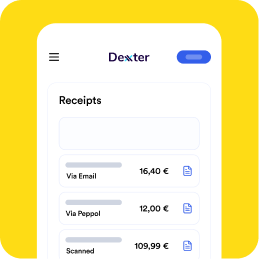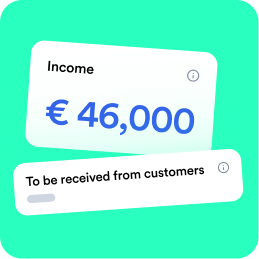A depreciation? Sounds like a complicated financial concept that gives you a headache? No worries! In this article, we’re going to talk about depreciation using a simple numerical example to get you started.
What is depreciation? 🔎
Let’s start at the beginning. Depreciation is actually a way of reducing the value of a purchase as time passes. Imagine you buy a brand new bicycle. That bike is worth a lot of money at the time, but after a year it will no longer be brand new. It will have suffered wear and tear and may even have become a bit rusty. We call this loss of value depreciation.
The loss of value is the yearly cost to your business. Even if you spent €10,000 when you purchased the bike, the €10,000 is not the immediate cost in accounts.
Did you know.
An investment does not equal an expense. The depreciation on an investment is the cost.
Which purchases should you write off?
If you purchase inventory for your webshop, you don’t have to write it off. After all, you expect to sell it again without reducing the value of your stuff. Moreover, you don’t expect the inventory to stay in your business for a long time.
Just like you won’t write off new pens you buy for your office. Even if you expect these to last for a while, they are so cheap that you will enter them as an expense in 1 go. So there is also a minimum amount from when you have to think about entering them as investment.
So in general, you will want to write off more expensive purchases with a longer life span . Some examples are furniture, machinery, cars, computers….
And if I am subject to VAT?
You do recover the vAT in one go. Even though you book a purchase as an investment, with corresponding depreciations that go over many years.
So you recover the entire vAT amount on the purchase of an investment in one go via the vAT declaration.
Over how many years should I depreciate? ⌛
The government sets certain depreciation periods for each category, these are:
| buildings | 20 to 30 years |
| furniture | 5 to 10 years |
| new vehicles | 5 years |
| Used vehicles | 3 years |
| Laptop | 3 years |
| Mobile phone | 3 years |
| Machines | 10 years |
These are guidelines provided by the tax authorities themselves and you certainly don’t need to get bogged down with them! If you have arguments that make you choose other terms anyway, you can certainly deviate.

Tip from an accountant:
If you buy something second-hand as a self-employed person, you can perfectly justify a shorter depreciation period.
What methods of depreciation exist?
The most common methods of depreciation are:
-Linear depreciation: every year you write off the same amount.
-Degressive depreciation: you write off more at the beginning than at the end.
-Progressive depreciation: you depreciate less at the beginning of the life than at the end.
An example of straight-line depreciation
Linear depreciation: how does it work?
One of the most common methods used to calculate depreciation is the straight-line depreciation method. This method simply divides the cost of an investment over the estimated life of that purchase.
Imagine you own a company and you buy a shiny new machine for €10,000. You expect this machine to last five years before retiring. Using the straight-line depreciation method, you divide the purchase price by the number of years of its useful life. In this case, this is:
€10,000 / 5 years = €2,000 per year
That means you can put in €2,000 of the value of your machine as an expense every year, which is the yearly depreciation.
A practical example:
Say you bought the machine in January, you would depreciate €2,000 at the end of that year. But what about in the next few years? Here’s a simple chart to clarify the example:
- Year 1: €10,000 – €2,000 = €8,000
- Year 2: €8,000 – €2,000 = €6,000
- Year 3: €6,000 – €2,000 = €4,000
- Year 4: €4,000 – €2,000 = €2,000
- Year 5: €2,000 – €2,000 = €0
At the end of the fifth year, your machine is worth nothing in your company’s accounts. You have depreciated the full purchase price over its estimated five-year life.
An example from declining balance depreciation
You still bought a brand new machine for €10,000. But this time you decide to depreciate more in the first few years, because the machine loses more value in the first few years.
How much more? That’s up to you to choose! For example, you can reduce by equal amounts:
- Year 1: €10,000 – €3,000 = €7,000
- Year 2: €7,000 – €2,500 = €4,500
- Year 3: €4,500 – €2,000 = €2,500
- Year 4: €2,500 – €1,500 = €1,000
- Year 5: €1,000 – €1,000 = €0
An example of progressive depreciation
You still bought a brand new machine for €10,000. But this time you decide to depreciate less in the first few years, because the machine loses less value in the first few years.
How much less? That’s up to you to choose! For example, you can increase by equal amounts:
- Year 1: €10,000 – €1,000 = €9,000
- Year 2: €9,000 – €1,500 = €7,500
- Year 3: €7,500 – €2,000 = €5,500
- Year 4: €5,500 – €2,500 = €3,000
- Year 5: €3,000 – €3,000 = €0

Tip from an accountant
If you make a €10,000 purchase, your tax benefit will be about half due to the tax burden. But don’t incur useless expenses, you still have to pay for your purchases….
What if not the entire purchase is business?
If you want to bring in the purchase of your newest Iphone, then you know yourself that you will also use that Iphone personally. Unfortunately, in a sole proprietor, that therefore means that you may not bring in the full amount as a cost (or investment).
So you have come to the conclusion that you will use your mobile phone 50% for business purposes. Which therefore means that you can enter a maximum of 50% of the purchase amount as investment, with corresponding depreciations.
What if you purchase something in the middle of the year?
If you purchase something in the middle of the year, the depreciation amount will be updated to how many days are left in that year.
For example, you buy a €3,600 computer on 1 December that you depreciate over 3 years. Then there will only be 1 month of use that year , so €100 will be added to the cost.
But in a sole proprietors’ business, you are exceptionally still allowed to deviate from this rule! So you can purchase something on 1 December with your sole proprietors and still write it off for the whole year.
To do this, you can use ‘the fiscal date’ when booking in Dexxter, in order to write off more or less in the year of purchase.

Tip from an accountant
In Dexxter you can easily update the fiscal date and your depreciation will be calculated automatically.
Just keep in mind that this won’t change the total depreciation. After 3 years, you will still have depreciated €3,600.
How should you practically depreciate with your sole proprietors? 💪
Usually the choice is to depreciate on a straight-line basis . That is the simplest.
If you start accounting in Excel, you will have to manually keep track of all your depreciations. This can be very time-consuming. A better solution is accounting in Dexxter, where your investments are automatically added to your costs every year via depreciations.
So depreciation does not have to be a puzzling financial draft. The straight-line depreciation method makes it easy to spread the value of your investments over time. This helps you get a realistic picture of your company’s yearly costs.
So, the next time you make a big purchase, you’ll know how to calculate depreciation and can even navigate your way around the world of depreciations.












